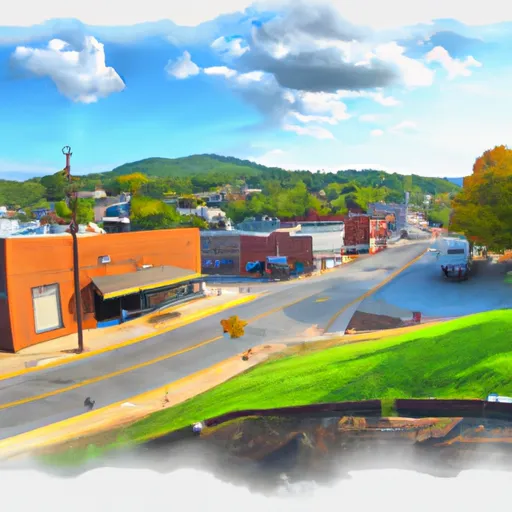-
 Snoflo Premium
Snoflo Premium
Get unlimited access to all our content
With no Ad interruptions! - Start Your Free Trial Login with existing account
Middlesboro
Eden Index
Climate
7.9
•
Recreation
4.6
•
Community
1.5
•
Safeguard
5.1/10

Middlesboro, Kentucky is a city located in Bell County in the southeastern part of the state. The climate in Middlesboro is classified as humid subtropical, characterized by hot and humid summers and mild winters. Average temperatures range from around 30°F (-1°C) in the winter to 85°F (29°C) in the summer, with moderate rainfall throughout the year.
The city is situated near the Cumberland Gap, an area known for its rich hydrology constituents. The Cumberland River flows through the region, providing opportunities for fishing, boating, and other water-based recreational activities. Middlesboro is also surrounded by lush forests, making it ideal for hiking, camping, and wildlife observation.
An outstanding outdoor recreation opportunity in Middlesboro is the Cumberland Gap National Historical Park, which offers over 85 miles of hiking trails, including part of the renowned Appalachian Trail. The park also features scenic overlooks, historic sites, and a visitor center with exhibits on local history and geology.
Overall, Middlesboro, Kentucky offers a diverse range of outdoor activities, allowing residents and visitors to explore the natural beauty and enjoy various recreational pursuits in this picturesque region.
What is the Eden Index?
The Snoflo Eden Index serves as a comprehensive rating system for regions, evaluating their desirability through a holistic assessment of climate health, outdoor recreation opportunities, and natural disaster risk, acknowledging the profound impact of these factors on livability and well-being.
Climate Health Indicator (CHI): 7.9
Middlesboro receives approximately
1276mm of rain per year,
with humidity levels near 81%
and air temperatures averaging around
13°C.
Middlesboro has a plant hardyness factor of
6, meaning
plants and agriculture in this region thrive during a short period during spring and early summer. Most
plants will die off during the colder winter months.
By considering the ideal temperature range, reliable water supplies, clean air, and stable seasonal rain or snowpacks, the Climate Health Indicator (CHI) underscores the significance of a healthy climate as the foundation for quality living.
A healthy climate is paramount for ensuring a high quality of life and livability in a region, fostering both physical well-being and environmental harmony. This can be characterized by ideal temperatures, reliable access to water supplies, clean air, and consistent seasonal rain or snowpacks.
Weather Forecast
Streamflow Conditions
Upper Cumberland
Area Rivers
Upper Cumberland
Snowpack Depths
Upper Cumberland
Reservoir Storage Capacity
Upper Cumberland
Groundwater Levels
Recreational Opportunity Index (ROI): 4.6
The Recreational Opportunity Index (ROI) recognizes the value of outdoor recreational options, such as parks, hiking trails, camping sites, and fishing spots, while acknowledging that climate plays a pivotal role in ensuring the comfort and consistency of these experiences.
Access to outdoor recreational opportunities, encompassing activities such as parks, hiking, camping, and fishing, is crucial for overall well-being, and the climate plays a pivotal role in enabling and enhancing these experiences, ensuring that individuals can engage in nature-based activities comfortably and consistently.
Camping Areas
| Campground | Campsites | Reservations | Toilets | Showers | Elevation |
|---|---|---|---|---|---|
| Moccasin Creek State Park | None | 1,881 ft | |||
| Desoto Falls | 44 | 2,195 ft | |||
| Andrews Cove | 10 | 2,056 ft | |||
| Vogel State Park | None | 2,323 ft | |||
| Upper Chattahoochee River | 34 | 2,209 ft | |||
| Boggs Creek | 31 | 1,798 ft | |||
| Wildcat 1 | 16 | 2,509 ft | |||
| Wildcat 2 | 16 | 2,667 ft | |||
| Low Gap Creek | 13 | 1,792 ft | |||
| Unicoi State Park | None | 1,678 ft |
Nearby Ski Areas
Catastrophe Safeguard Index (CSI):
The Catastrophe Safeguard Index (CSI) recognizes that natural disaster risk, encompassing floods, fires, hurricanes, and tornadoes, can drastically affect safety and the overall appeal of an area.
The level of natural disaster risk in a region significantly affects safety and the overall livability, with climate change amplifying these risks by potentially increasing the frequency and intensity of events like floods, fires, hurricanes, and tornadoes, thereby posing substantial challenges to community resilience and well-being.
Community Resilience Indicator (CRI): 1.5
The Community Resilience Indicator (CRI) recognizes that education, healthcare, and socioeconomics are crucial to the well-being of a region. The CRI acknowledges the profound impact of these elements on residents' overall quality of life. By evaluating educational resources, healthcare accessibility, and economic inclusivity, the index captures the essential aspects that contribute to a thriving community, fostering resident satisfaction, equity, and social cohesion.

